Abstract
Unlike previous studies on wind turbulence spectrum in the planetary boundary layer, this investigation focuses on high-altitude (1–5 km) wind energy spectrum and turbulence spectrum under various weather conditions. A fast Fourier transform (FFT) is used to calculate the wind energy and turbulence spectrum density at high altitudes (1–5 km) based on wind profiling radar (WPR) measurements. The turbulence spectrum under stable weather conditions at high altitudes is expressed in powers within a frequency range of 2 × 10−5–10−3 s−1, and the slope b is between −0.82 and −1.04, indicating that the turbulence is in the transition from the energetic area to the inertial sub-range. The features of strong weather are reflected less obviously in the wind energy spectrum than in the turbulence spectrum, with peaks showing up at different heights in the latter spectrum. Cold windy weather appears over a period of 1.5 days in the turbulence spectrum. Wide-range rainstorms exhibit two or three peaks in the spectrum over a period of 15–20 h, while in severe convective weather conditions, there are two peaks at 13 and 9 h. The results indicate that spectrum analysis of wind profiling radar measurements can be used as a supplemental and helpful method for weather analysis.
Similar content being viewed by others
References
Atkinoon, B. W., 1981: Mesoscale Atmospheric Circulations. Academic Press, 495 pp.
Bian Jianchun, Qiao Jinsong, and Lu Daren, 2002: Laboratory for middle atmosphere and global environment observation. Chinese J. Atmos. Sci., 26, 474–480. (in Chinese)
Bowne, N. E., and J. T. Ball, 1970: Observational comparison of rural and urban boundary layer turbulence. J. Appl. Meteor., 9, 862–873.
Chellali, F., A. Khellaf, and B. Adel, 2010: Application of time-frequency representation in the study of the cyclical behavior of wind speed in Algeria: Wavelet transform. Stochastic Environmental Research and Risk Assessment, 24, 1233–1239.
Deng Chuang, Ruan Zheng, Wei Ming, et al., 2012: The evaluation of wind measurement accuracy by wind profile radar. J. Appl. Meteor. Sci., 23, 523–533. (in Chinese)
Endlich, R. M., R. C. Singleton, and J. W. Kaufman, 1969: Spectral analysis of detailed vertical wind speed profiles. J. Atmos. Sci., 26, 1030–1041.
Griffith, H. L., H. A. Panofsky, and I. van der Hoven., 1956: Power-spectrum analysis over large ranges of frequency. J. Atmos. Sci., 13, 279–282.
Højstrup, J., 1981: A simple model for the adjustment of velocity spectra in unstable conditions downstream of an abrupt change in roughness and heat flux. Bound.-Layer Meteor., 21, 341–356.
Kaimal, J. C., J. C. Wyngaard, Y. Izumi, et al, 1972: Spectral characteristics of surface layer turbulence. Quart. J. Roy. Meteor. Soc., 98, 563–589.
—, and J. J. Finnigan, 1994: Atmospheric Boundary Layer Flows: Their Structure and Measurement. Oxford University Press, 1–279.
Kolmogorov, A. N., 1941a: The local structure of turbulence in incompressible viscous fluid for very large Reynolds number. Math. Phys. Sci., 434, 9–13.
—, 1941b: Dissipation of energy in the locally isotropic turbulence. Math. Phys. Sci., 434, 15–17.
Liu Shuyuan, Zheng Yongguang, and Tao Zuyu, 2003: The analysis of the relationship between pulse of land heavy rain using wind profiler data. J. Trop. Meteor., 19, 285–290. (in Chinese)
Liu Xiaohong and Hong Zhongxiang, 1996: A study of the structure of a strong wind event in the atmospheric boundary layer in Belting area. Scientia Meteor. Sinica, 20, 223–228. (in Chinese)
Luo Jianyuan and Zhu Ruizhao, 1993: The analysis of wind spectrum characteristics in surface layer in Badaling area of Beijing. Acta Energiae Solaris Sinica, 14, 279–287. (in Chinese)
Panofsky, H. A., 1955: Meteorological applications of power-Spectrum analysis. Bull. Amer. Mcteor. Soc., 36, 163–166.
—, D. Larko, R. Lipschutz, et al., 1982: Spectra of velocity components over complex terrain. Quart. J. Roy. Meteor. Soc., 108, 215–230.
Sheng Peixuan, Mao Jietai, Li Jianguo, et al., 2003: Atmospheric Physics. Beijing University Press, Beijing, 227–228. (in Chinese)
Sun Aidong and Xu Yumao, 1997: Spectral characteristic and multi-scale analysis of a wet cold front in boundary-layer atmosphere. Scientia Atmos. Sinica, 17, 18–27. (in Chinese)
Sun Jisun, He Na, Wang Guorong, et al., 2012: Preliminary analysis on synoptic configuration evolvement and mechanism of a torrential rain occurring in Beijing on 21 July 2012. Torrential Rain and Disasters, 31, 218–225. (in Chinese)
Tian Yuji, Yang Qingshan, Yang Na, et al., 2011: Beijing meteorological tower statistical model of turbulent wind velocity spectrum. Scientia Sinica (Technologica), 41, 1460–1468. (in Chinese)
Van der Hoven, I., 1957: Power spectrum of horizontal wind speed in the frequency range from 0.0007 to 900 cycles per hour. J. Meteor., 14, 160–164.
Wang Hua, Sun Jisong, and Li Jin, 2007: A comparative analysis on two severe hail events in Beijing urban district in 2005. Meteor. Mon., 33, 49–56. (in Chinese)
Wang Xinyan and Mao Jietai, 2004: The wavelet application in the research of mesoscale convective activity features. J. Trop. Meteor., 20, 549–560. (in Chinese)
Wei Fengying and Zhang Ting, 2009: Frequency distribution of drought intensity in Northeast China and relevant circulation background. Journal of Natural Disasters, 18, 1–7. (in Chinese)
Yu Xiaoding, 2012: Investigation of Beijing extreme flooding event on 21 July 2012. Meteor. Mon., 38, 1313–1329. (in Chinese)
Zhang Xiaoping, Lü Naiping, and Zhou Mingyu, 1987: The characteristics of vertical distribution of low-frequency spectra for horizontal wind velocity in the atmospheric boundary layer. Chinese J. Atmos. Sci., 11, 31–39. (in Chinese)
Zhao Deshan, Wang Lizhi, and Hong Zhongxiang, 1982: Analysis on the structure of gust in boundary layer when a cold front passing. Chinese J. Atmos. Sci., 6, 324–332. (in Chinese)
Author information
Authors and Affiliations
Corresponding author
Additional information
Supported by the National Natural Science Foundation of China (41075023 and 41475029), China Meteorological Administration Special Public Welfare Research Fund (GYHY201306004), and Key Technology Integration and Application Fund of the China Meteorological Administration (CMAGJ2013M74).
Rights and permissions
About this article
Cite this article
Ruan, Z., Mu, R., Wei, M. et al. Spectrum analysis of wind profiling radar measurements. J Meteorol Res 28, 656–667 (2014). https://doi.org/10.1007/s13351-014-3171-y
Received:
Accepted:
Published:
Issue Date:
DOI: https://doi.org/10.1007/s13351-014-3171-y




